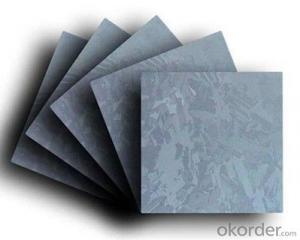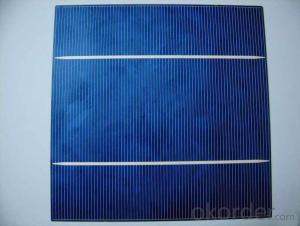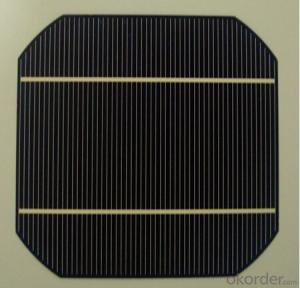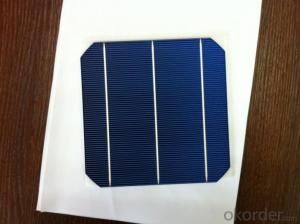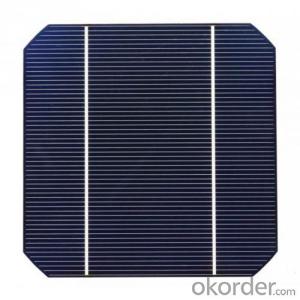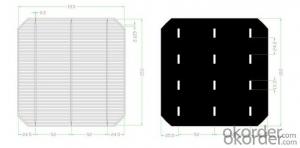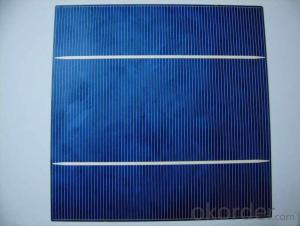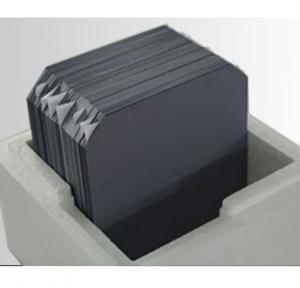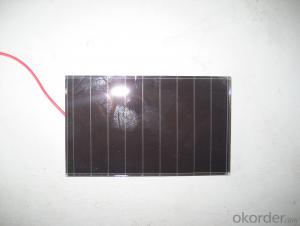Mono Solar Cells156mm*156mm in Bulk Quantity Low Price Stock 18.4
- Loading Port:
- Shanghai
- Payment Terms:
- TT OR LC
- Min Order Qty:
- 1000 pc
- Supply Capability:
- 100000 pc/month
OKorder Service Pledge
OKorder Financial Service
You Might Also Like
Brief Introduction
- Up to 20.0% efficiency, one of the highest performing mono crystalline cells on the market
- Three bus bars boosts current collection over the entire cell area, leading to higher fill factors
- Blue anti-reflecting coating allows more sunlight be captured and converted to electricity
- Finer, closer fingers improves charge collections for improved energy yield
- Lower light-induced degradation leads to greater power output over the entire module lifetime
- All solar cells are tightly classified to optimize output of module
- Maximum yield and longevity due to hotspot prevention
- Premium appearance results in a highly uniform and aesthetically appealing module
Specification
- Product Mono-crystalline silicon solar cell
- Dimension 156 mm x 156 mm ± 0.5 mm
- Thickness 200 μm ± 30 μm
- Front 1.5 ± 0.1 mm busbar (silver)
- Silicon nitride antireflection coating
- Back 3.0 mm continuous soldering pads (silver)
- Back surface field (aluminum)
Electric performance parameters

- Testing conditions: 1000 W/m2, AM 1.5, 25 °C, Tolerance: Efficiency ± 0.2% abs., Pmpp ±1.5% rel.
- Imin : at 0.5 V
Light Intensity Dependence
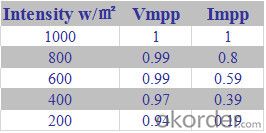
Soldering Ability
- Peel Strength: > 1.0 N/mm (Pull soldered ribbon from busbar in 5 mm/s of 180°)
Dimension Figure

Quick Response
- Any time and anywhere, reply clients' email and solve all problems happen in the work at the first time.
- Remove clients doubts and offer the best solution at the first time.
- Give our clients the lastest news of the photovoltaic, update the newest stock informtion.
Production and Quality Control
- Precision cell efficiency sorting procedures
- Stringent criteria for color uniformity and appearance
- Reverse current and shunt resistance screening
- ISO9001,ISO14001 and OHSAS 18001,TUV Certificated


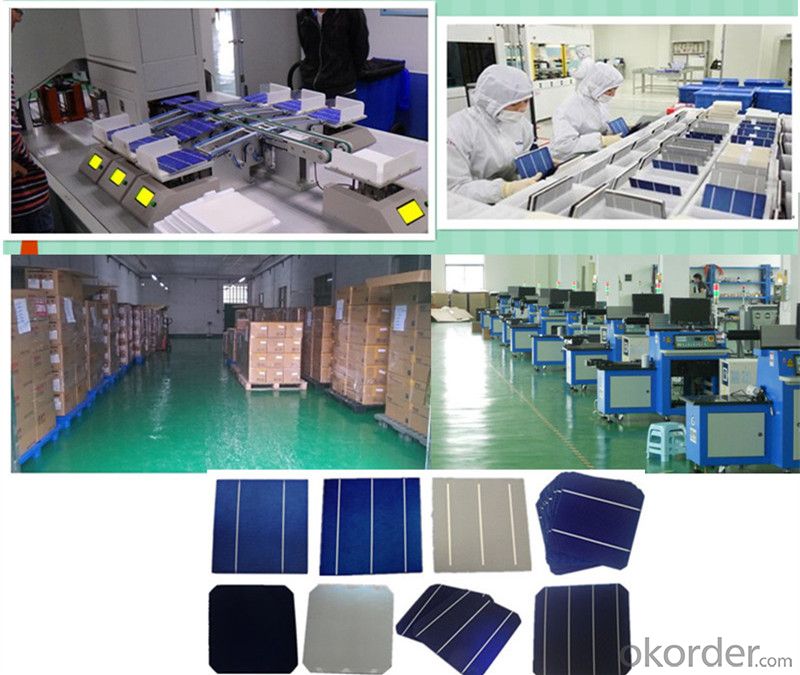
FAQ:
1. Q: Do you have your own factory?
A: Yes, we have. Our factory located in Jiangsu
2. Q: How can I visit your factory?
A: Before you visit,please contact us.We will show you the route or arrange a car to pick you up.
3. Q: Do you provide free sample?
A: Commenly we provide paid sample.
4. Q: Could you print our company LOGO on the nameplate and package?
A: Yes, we accept it.And need an Authorization Letter from you.
5. Q: Do you accept custom design on size?
A: Yes, if the size is reasonable.
6. Q: How can I be your agent in my country?
A: Please leave feedback. It's better for us to talk about details by email.
7. Q: Do you have solar project engineer who can guide me to install system?
A: Yes, we have a professional engineer team. They can teach you how to install a solar system.
- Q:Can solar silicon wafers be used in solar-powered water pumping systems?
- Yes, solar silicon wafers can be used in solar-powered water pumping systems. These wafers are a crucial component in photovoltaic cells, which convert sunlight into electricity. By harnessing solar energy, these systems can power water pumps, allowing for sustainable and environmentally friendly water pumping solutions.
- Q:How do solar silicon wafers perform in high-humidity environments?
- Solar silicon wafers generally perform well in high-humidity environments. The silicon material used in the wafers is non-reactive to moisture, and the solar cell manufacturing processes ensure the wafers are adequately protected from humidity. However, excessive moisture can cause a slight decrease in performance due to the formation of a thin layer of water on the surface, which can reduce light transmission. Overall, solar silicon wafers are designed to withstand high-humidity environments without significant degradation in performance.
- Q:Are there any advancements in solar silicon wafer surface texturing techniques?
- Yes, there have been advancements in solar silicon wafer surface texturing techniques. Researchers and engineers have been exploring various methods to enhance the efficiency of solar cells by improving the light absorption capacity of silicon wafers. Some recent advancements include laser texturing, chemical etching, and nano-imprinting techniques, which help create unique surface textures that increase the trapping and absorption of sunlight, leading to improved energy conversion. These advancements aim to maximize the performance of solar cells and contribute to the overall growth and adoption of solar energy technology.
- Q:Can solar silicon wafers be used in other electronic devices?
- Yes, solar silicon wafers can be used in other electronic devices. These wafers are commonly used to manufacture solar cells for solar panels, but they can also be utilized in various other electronic applications such as integrated circuits, sensors, and microchips. The high purity and quality of solar silicon wafers make them suitable for use in a wide range of electronic devices.
- Q:What are the advantages of using a solar silicon wafer in solar cells?
- Using a solar silicon wafer in solar cells offers several advantages. Firstly, silicon is abundant and readily available, making it cost-effective for mass production. Secondly, silicon has excellent electrical properties, allowing for efficient conversion of sunlight into usable electricity. Additionally, silicon is durable and has a long lifespan, ensuring the longevity of solar cells. Furthermore, silicon wafers can be easily customized and integrated into various sizes and shapes, providing flexibility in design and application. Overall, the use of solar silicon wafers in solar cells contributes to sustainable energy production, affordability, efficiency, and versatility.
- Q:What is the impact of wafer resistivity on solar silicon wafer performance?
- The wafer resistivity of a solar silicon wafer has a significant impact on its performance. Lower resistivity allows for better conductivity and reduces the amount of energy lost as heat during the conversion process. This results in higher efficiency and improved overall performance of the solar cell. Additionally, low resistivity helps in minimizing the series resistance, enabling better current flow and maximizing the power output of the solar cell.
- Q:Why can silicon chips store information? Even if it is a miniature circuit, unplug the power on the use of electricity, there is no electricity in the silicon chip, in the form of what capacity storage
- The principle of the board as you say, the power can be changed according to the requirements of the crystal in the electronic case, the power will not stop after the move, but also as the pawn as the preservation of information,
- Q:Are there any environmental concerns with the production or disposal of solar silicon wafers?
- Yes, there are some environmental concerns associated with the production and disposal of solar silicon wafers. The production process of silicon wafers requires significant energy consumption and can contribute to carbon emissions if the energy source used is not renewable. Additionally, the extraction of raw materials, such as quartz, for silicon production can have negative environmental impacts. In terms of disposal, while silicon wafers are not typically hazardous waste, improper disposal can still contribute to electronic waste accumulation and pose potential risks if not managed properly. However, it is important to note that compared to other forms of energy production, the overall environmental impact of solar silicon wafer production and disposal is still relatively low.
- Q:Can solar silicon wafers be used in building-integrated photovoltaics (BIPV)?
- Yes, solar silicon wafers can be used in building-integrated photovoltaics (BIPV). BIPV refers to the integration of solar panels or cells into the building envelope, such as windows, roofs, or facades. Silicon wafers are commonly used in the production of solar cells, including those used in BIPV systems. These wafers are processed to create solar cells, which can then be integrated into various building materials, allowing for the generation of solar power while also serving as functional building elements.
- Q:How much does a solar silicon wafer weigh?
- A solar silicon wafer typically weighs around 4-6 grams.
1. Manufacturer Overview |
|
|---|---|
| Location | |
| Year Established | |
| Annual Output Value | |
| Main Markets | |
| Company Certifications | |
2. Manufacturer Certificates |
|
|---|---|
| a) Certification Name | |
| Range | |
| Reference | |
| Validity Period | |
3. Manufacturer Capability |
|
|---|---|
| a)Trade Capacity | |
| Nearest Port | |
| Export Percentage | |
| No.of Employees in Trade Department | |
| Language Spoken: | |
| b)Factory Information | |
| Factory Size: | |
| No. of Production Lines | |
| Contract Manufacturing | |
| Product Price Range | |
Send your message to us
Mono Solar Cells156mm*156mm in Bulk Quantity Low Price Stock 18.4
- Loading Port:
- Shanghai
- Payment Terms:
- TT OR LC
- Min Order Qty:
- 1000 pc
- Supply Capability:
- 100000 pc/month
OKorder Service Pledge
OKorder Financial Service
Similar products
New products
Hot products
Hot Searches
Related keywords





